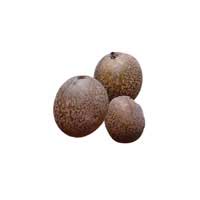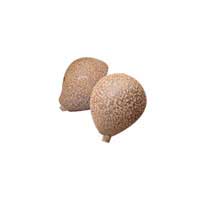 Full List of Fruits
Full List of Fruits  Nonda plum Fruit
Nonda plum FruitNonda Fruit
![]() Introduction of Nonda plum Fruit
Introduction of Nonda plum Fruit
Scientific name - Parinari nonda
Parinari nonda commonly recognized as Nonda plum is a small tree or a shrub which has its roots in the family Chrysobalanaceae. It bears edible fruit which seeds are surrounded by brown hairs and they are generally harvested in the wild. In general, it occurs in Northern Australia and New Guinea. Nonda Tree, Nunda Plum and Parinari are some of its common names. The fruits are ovoid-globular in shape and are pericap fleshy just about 30-40 x 25-35 mm in size. Having a hard endocarp and bony, they are about 25 x 15 mm, outer surface rough and reticulate.
![]() Nutritional Value of Nonda plum Fruit
Nutritional Value of Nonda plum Fruit
| Total Fat 3g | 5% |
| Saturated Fat -1g | -5% |
| Cholesterol -1mg | -0% |
| Sodium 20mg | 1% |
| Total Carb 8.7g | 3% |
| Dietary Fiber 8.1g | 32% |
| Sugars -1g | |
| Protein 2.8g | 6% |
| Vitamin A -0% | Vitamin C -2% |
| Calcium 0% | Iron 17% |
With regards to the environment, P. nonda varies considerably in habit. Rising and falling to hilly plateau of either sandstone or basalt and on alluvial plains, in general a small to medium-sized tree 6 - 15 metres tall; despite exceptional specimens can reach 34 metres in height.
Preferring sunny position, the tree thrives in deep, well-drained sandy to loamy soil. It can be found up to elevations of 1300 metres. In addition it can tolerate a pH range of 4.5 - 8, and prefers 5.5 - 7. Goes well with a mean annual rainfall in the range 1,100 - 1,600mm, but tolerates 700 - 1,800mm.
When propagating Nonda fruit, it is important to select a healthy and vigorous cutting from the parent plant. The cutting should be at least six inches long and should have a mature woody stem. It should also have at least three healthy leaves. Once the cutting has been selected, it should be cut just below a node on the stem, where a small branch is present.
The cutting should then be planted in a pot filled with moist soil. The soil should be acidic and well-draining, and it should be kept moist but not soggy. The cutting should be placed in a partially shaded area and should be watered regularly.
After the cutting has been planted, it should be monitored to ensure that it is receiving adequate sunlight and water. After the cutting has established itself in the pot, it can be transplanted into the ground.
When planting Nonda fruit in the ground, it is important to select an area with well-draining soil and full sun. The soil should be kept slightly moist, but not soggy. The tree should be planted in a hole that is at least twice as wide and deep as the root ball. The tree should be firmly planted in the soil and mulched around the base.
Once the tree is planted, it should be watered regularly. Nonda fruit trees require regular pruning in order to maintain their shape and to encourage fruiting. It is also important to fertilize the soil with a balanced fertilizer every few months.
Nonda fruit trees will usually begin to bear fruit within two to three years of planting. The fruits can be harvested when they are ripe, usually in the late summer or early fall. The fruits can be eaten fresh or used to make jams, jellies, and sauces.
Nonda fruit is a relatively easy species to propagate, and it can thrive in many different climates and conditions. By following the proper propagation and care instructions, it is possible to grow and harvest a bountiful crop of Nonda fruit.


















